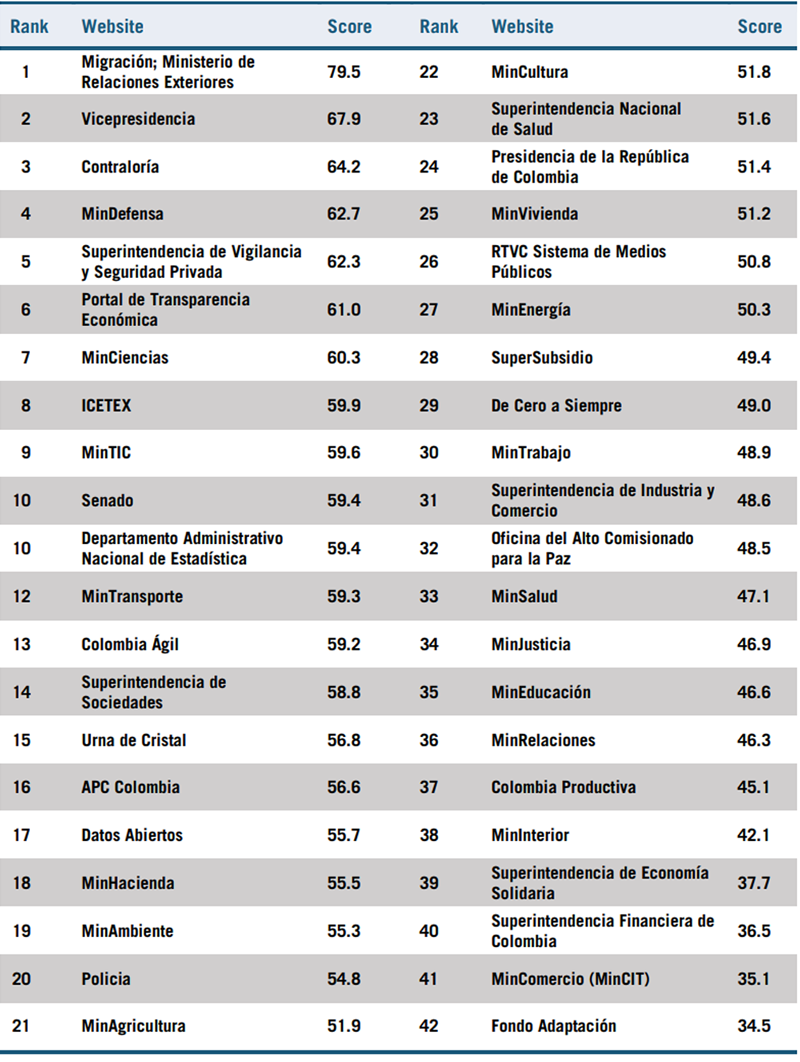Assessing Colombian Government Websites
Citizens and businesses rely on government websites to access important information and services. Unfortunately, many Colombian government websites fail to meet basic website standards for security, speed, mobile friendliness, and accessibility.
The coronavirus pandemic has highlighted the importance of citizens and businesses having secure and reliable access to online government services. Unfortunately, many Colombian government websites fail to meet basic website standards. This report used publicly available tools to test the page-load speed for both desktop and mobile browsers, mobile-friendliness design, security, and accessibility of 42 Colombian government websites. All websites failed at least one test. Many of the sites are slow, difficult to use on mobile devices, inaccessible, and insecure. As such, they make it unnecessarily difficult to find government information online and expose users to security risks.
To assess whether Colombian government websites performed adequately, we compared their performance to the performance of 20 popular nongovernment Colombian websites, such as Wikipedia.org and eltiempo.com. We established a benchmark score for each test—typically one standard deviation below the average score of popular nongovernment websites—and Colombian government sites had to meet or exceed a test's benchmark to pass.
Many Colombian government websites performed poorly on both page-load speed and mobile-friendliness tests. For example, only 38 percent of Colombian government websites passed the desktop page-load speed test, and less than five percent passed the mobile page-load speed test. Almost 60 percent of sites passed the mobile-friendliness test. Only two websites passed both the mobile page-load speed and mobile-friendliness tests. The latter statistic is particularly concerning because more than half of Colombia's population uses a mobile device to access the Internet. The two websites that passed both the mobile page-load speed test and the mobile-friendliness test are the Superintendency of Corporation's website (Superintendencia de Sociedades) and the Colombian Migration website (Migración; Ministerio de Relaciones Exteriores).
Many Colombian government websites also did not perform well on security. This report reviews two security features. The first is Hypertext Transfer Protocol Secure (HTTPS), a standard protocol to encrypt communications between web browsers and websites. The second is Domain Name System Security Extensions (DNSSEC), a set of protocols used to verify the IP address associated with a particular domain name is authentic. We used a tool that analyzes Secure Sockets Layer (SSL) and Transport Layer Security (TLS) certificates, which are used by most HTTPS connections, to test that the websites had enabled and adequately configured HTTPS. We found that 67 percent of Colombian government websites passed the HTTPS test. This result means that users could not privately and securely browse one-third of the sites we tested. In addition, we used a tool to determine whether the domain of each state government website used DNSSEC. We found that less than three percent of Colombian government websites had correctly enabled DNSSEC for their domain name. The only site that passed was the Vice President's website (Vicepresidencia).
Lastly, 48 percent of Colombian government websites passed the accessibility test. Five sites received a perfect score on a 0-to-100-point scale, but five websites also received scores below 60. These latter websites are likely highly inaccessible, meaning they are difficult for people with disabilities to use, including the more than 250,000 Colombians who are blind.
We used the Colombian government websites scores for each test to calculate an overall 0-to-100-point scale score for every site. The Colombian Migration website (Migración; Ministerio de Relaciones Exteriores) performed the best by a wide margin. It received a score of 79.5, which is roughly 15 points better than the next best website. Overall, the five best performing Colombian government websites we tested are:
- Colombia Migration, (Migración; Ministerio de Relaciones Exteriores)
- Vice-Presidency (Vicepresidencia)
- Office of the Comptroller General of Colombia (Contraloría)
- Ministry of National Defense (MinDefensa)
- Vigilance and Private Security Superintendency (Superintendencia de Vigilancia y Seguridad Privada)
The five lowest-performing sites are:
- Adaptation Fund (Fondo Adaptación)
- Ministry of Commerce, Industry and Tourism (MinComercio)
- Financial Superintendency of Colombia (Superintendencia Financiera de Colombia)
- Superintendency of Solidarity-based Economy (Superintendencia de Economía Solidaria)
- Ministry of the Interior (MinInterior)
All Colombian government websites can make improvements. The Colombian government should take the following actions to ensure its citizens have access to fast, mobile-friendly, secure, and accessible government websites:
- Creating security requirements
- Establishing a mobile-first strategy
- Moving all websites to the cloud
- Testing the accessibility of websites with local partners
- Launching a website modernization sprint
- Authorizing websites to operate for a set period
Table 1 presents the overall rankings of Colombian government websites using a 0-to-100-point scale.
Table 1: Overall Rankings of Colombian Government Websites

Editors’ Recommendations
November 27, 2017
Benchmarking U.S. Government Websites: Update
November 27, 2017

